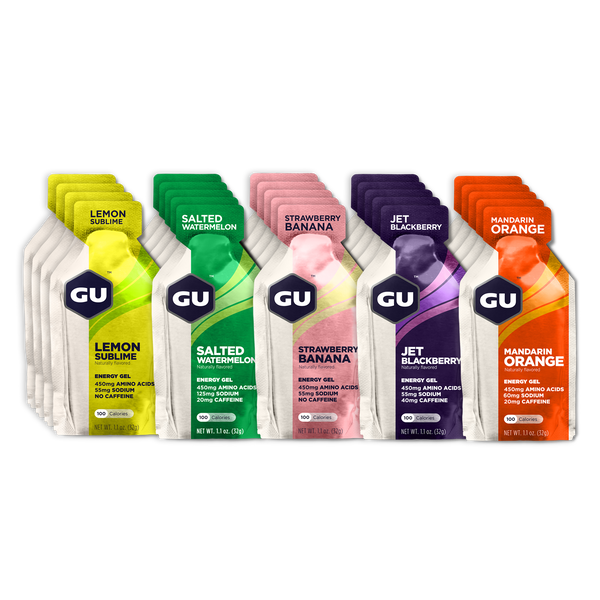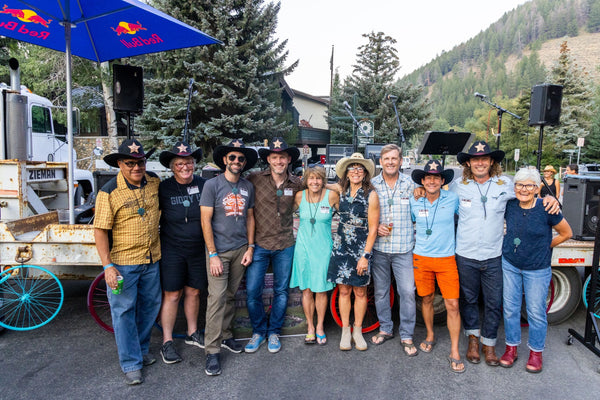the ultimate race for amphibious people
Endurance athletes are an interesting breed. We go to great lengths to discover the limits of our bodies, only to push the envelope by finding ways to increase the challenge. By creating ultramarathons and extending triathlons, we are convinced to create new thresholds once we break through what’s been accomplished. Running, biking, and triathlon races have been the most popular endurance events for decades, with little to disrupt their dominance (although obstacle course races have been making waves in recent years.) However, there is a new twist to classic endurance races, and although it “only” includes running and swimming, it is a beast unlike any other in the endurance scene. Introducing the swimrun.

what is swimrun?
To put in the simplest of terms, swimrun is exactly what it sounds like: an endurance racing event that combines swimming and running. Racers swim from one piece of land to the other (usually island to island) through open water, oftentimes in near-freezing temperatures. Afterwards, they run, climb, slide and crawl across the land, only to hop back into water to repeat that process many more times. ÖtillÖ (Swedish for “Island to Island”) is the original swimrun, consisting of 26 islands, 52 transitions, and 75 kilometers of combined swimming and running.

Drunk bet to world championships
The swimrun dates back to 2002 in Sweden, when a local hotel owner and a couple of his employees created a drunken bet after work. The challenge: race in pairs to the town of Sandhamn, with a time limit of 24 hours. The single rule was that they had to hit checkpoints at three restaurants scattered on islands between ÖtillÖ and Sandham. Losing team had to pay for the hotel stay, dinner and drinks. The following morning, the “original 4” raced through 26 islands, swimming 6 miles and running the other 41 miles. Both teams missed the 24-hour deadline and were too exhausted on arrival to celebrate their trek. They did the same challenge the following year and found the same result.
In 2006, an attempt was made to develop a commercial race out of the Swedish island-hopping challenge. After a couple years of few teams and almost an equal number of DNFs, race developers learned a helpful secret: the only way to complete the race is by moving the whole time and not taking any breaks. Year by year the race picked up steam, and now it is an internationally recognized event with a World Championships. It is considered one of the most difficult races in the world by CNN (and most people who have attempted the race.)
The late Jeff Cole and other Americans who experienced the original ÖtillÖ brought the race to the U.S. in 2015, and it featured a dozen athletes on a five-island jaunt. It evolved to become Casco Bay Swimrun in 2016, and was praised for feeling similar to the Swedish standard.
That year, there were only four small swimrun events in the North America. In 2018, there were over a dozen in North America, over a hundred throughout Scandinavia and the rest of the world. It’s growing fast as triathletes, trail runners and swimmers are finding this challenging, team-based, sport with a laid-back, unpretentious, fun-loving vibe something that is strangely attractive.

Photo credit: Tim Net —truespeedphoto.com
Rules & Equipment
The founders of swimrun pride themselves in having as few rules as possible, so there are only a couple essential parameters. Firstly, the event is held outdoors on a course with at least 2 swim and run sections each (although most swimruns have dozens.) Next, all participants must carry their equipment for the whole race. Some participants use hand paddles and a swim pull buoy to help propel them through the water, which must be below the size limit. They also wear grippy shoes along with modified wetsuits and goggles. The rest of their equipment includes fuel, clothes and other items that each racer deems necessary. Swimruns range from Super Sprints under 10km to over 75km.
The swimrun is actually a team event, with people working together in pairs of two. Each team member must do the whole race together, so they don’t catch much of a break aside from accompanying each other.

recap
This event is fast-paced, dynamic, and extremely…amphibious. Having trouble conceptualizing what this event looks like? Recently, Marcus Barton filmed his race by holding a GoPro with his mouth at the Rockman SwimRun (Rockman is another swimrun race, based off a local mythological legend in Norway. You can read more on it here.) Having completed 15 swimruns, Marcus is likely the most experienced racer in North America. To get a complete, first-person account on the swimrun experience, check out his report below and get a glimpse into one of the world’s most unique and fast-growing endurance events.
Rocks in my Shoes - RockMan Swimrun
by Marcus Barton

Mirko and Hendrik of Team Amphibia Wolfsburg passed us again, getting out of the water just ahead of us. It was definitely the coldest swim so far and it showed. As the four of us stumbled into the aid station, all of us cramping. Thor asks us each how we were doing. We were all smiles and thumbs-up on the surface, but underneath, we were all suffering in some form or fashion.

Up to that point we had just finished our 4th swim and were on our way onto our 5th run, inappropriately named, “The Seaside Sprint”. Inappropriate as there is nothing “sprint” about it. It was one of the most technical portions of the course with tons of boulders, waterfalls to traverse and cliff-side scrambles. It was a cruel joke for a name, but we loved the joke just as much as we loved the extreme technical nature of this section.

Let’s jump back to the beginning of the race. Dan and I had raced a ton and trained even more for this race. We knew It would be the biggest race of the year so far and definitely the hardest. I raced Rockman back in 2015 as a last-minute, fill-in partner for Dan. It was my first swimrun and as you can see, certainly not my last. Dan saw the course again last year, so we felt like we knew what preparation was necessary going in. And prepare we did. Like most weekend-warriors, Dan and I both have full-time jobs and families. We’ve struggled over 2018 to fit in everything and still get in plenty of training. Somehow, it has worked out and I think we were as prepared as we could be going into the race. As we stood on the plank of the ferry, getting ready to jump in, Thor, the race director snaps a selfie. As I smile into the camera, the butterflies hit… or was that my need to go pee?

We hopped in the water and took off swimming towards the lead mixed team of Simon Börjeson and Marika Wagner (an Ötillö World Champion). She was part of the winning team last year and has also finished 2nd overall a Ötillö. Simon, well, he designed the Rockman course. We knew they would be a force to be reckoned with. After jumping off the ferry and starting our swim, It wasn’t but about 500 meters in when Mirko and Hendrik passed us. We had seen quite a few jellyfish in the crystal-clear water, but we didn’t see the three-footer that Dan swam right over until it was too late. He managed to escape with just a minor sting on his left arm.

We scrambled up the hillside keeping them in sight all the way up to three more swims and then running up to Preikestolen, also known as Pulpit Rock. For the racers new to Rockman, this would be a very quick preview of what they were in store for. The bulk of the “running” in Rockman is scrambling across very technical terrain.

The climb up from the fjord to the top of Preikestolen is a good 2000 foot climb with its share of muddy, mossy fields and non-stop boulder step climbs. Although some of the climb up is a tourist path that thousands of people visit per day, very few RUN up it. Dan and I walked as little as possible, usually reserved for the steepest steps. The rest, we were running. They advertise it as a two-hour hike. We would ascend it in less than 40 minutes. Luckily for us, it was foggy and raining. This meant minimal tourists. On the flip side, it also meant we wouldn’t have the privilege of some of the most epic scenery on the planet.

This is what the final climb up to Pulpit Rock looked like during the race. Since we were in the clouds, you couldn’t really get an idea of how far down it was. The rocks were very wet with the rain, making it difficult to find sure footing and not sliding off the side of the mountain.

With other friends from the U.S. making this race, I was a bit disappointed that they didn’t get to experience all of the beautiful views that Pulpit Rock has to offer. They had no idea how much they had truly climbed since they couldn’t see the fjord below. I would later go back the next day to capture t for them. We had clear skies for the most part, so I captured:

On our way back down to the fjord, we would hit some more technical train running. I’m not talking your typical “technical trail running” like what we have back in the United States. These trails would be classified, back home, as very technical hiking trails. Most runners would not think these were running trails. Not even close. We caught up to Mirko and Hendrik and passed them. They stuck with us for the bulk of the run, even with us swapping places a couple of times. We chatted a little, joked a little, but for the most part, we were all just concentrating on the run and not breaking something. Towards the end of the run, we pulled away a little, but not out of sight.
As we entered the “Hillside Swim”, named for it’s beautiful cliff-side views, we knew it would be a cold one. The second longest swim of the day at 1500 meters, we settled into a good pace and tried to watch out for the jellyfish, like the one that tagged Dan in the first swim. Mirko and Hendrik passes us right before the exit and we climbed up the chain out of the water.

Heading into the Seaside Sprint, I was ecstatic. I had figured out that with the training that Dan and I had accomplished, coupled with what we had experienced so far in the race, that this would be our strength. If we were going to gap these guys, it would have to be on this section. For most of the first half and even into the second, they kept up with us. However, when things got really technical, Dan and I pushed harder and eventually pulled away. This portion of the course is the most technical. You use your hands just as much as you use your feet. You’re constantly jumping down off of boulders, grabbing rocks, trees and what-not to help propel you forward.

In addition to the constant battle of overcoming rocks, boulders and other land-based obstacles, you also have to contend with water crossings as well. These aren’t your typical creek crossings, but fast moving, rapid water. At this point in the race, I had somehow picked up small, sharp rocks in my shoes, so I was hoping that with each water crossing, they would somehow make it out of my shoes.

We arrived at Songesand and picked up our GPS device (that somehow missed the ferry to the start) and ran up the 6 km (4 mile) paved run up to the farmer’s house (Kåsen Gård). As we pulled out of sight on the road, there was still no sign of Mirko and Hendrik.
Arriving at the Farmer’s house was a welcomed relief. It meant that most of the climbing on the pavement was almost over. Although not very steep, it just seems to nag at you, especially that late in the race. We arrived at the aid station there and were welcomed by waffles!!

After another steep, technical downhill section where the rocks in my shoes were jabbing my toes. They’ll eventually come out, I thought, not wanting to take the time to stop and clean them out. On this section of steep downhill, all of the rocks were slippery and mossy. After descending and trying to keep sure footing, we finally made it down to Kåsaklubben which is the dock for the 1700 meter (a little over a mile) fjord crossing. This was the longest swim of the day and one where you have to fight the tidal currents. I was tired and my arms didn’t want to swim. They had been used so much during the technical runs that they were not happy having to do more work in the water. I know I was holding Dan back. Just like last time, every time I looked up, that huge white building still looked way too small and not getting any closer.

Finally making it across the fjord, we had a team pass us just before the ladder. As they climbed out, I recognized their jersey number as Mirko and Hendrik. They had closed the gap!! We managed to get through the aid station and onto the long stair climb ahead of them. As we climbed, they stayed about 30-50 steps down.


The Flørli stairs make up the longest wooden staircase in the world. An advertised 4,444 steps, they rise over 2,000 vertical feet in less than a mile. Following the water pipeline up to snow-fed lakes, they vary in pitch, as well as height and depth of the steps. Several times I stopped momentarily to allow my legs to rest, even if only for 2 or 3 seconds, and to throw out a few choice words. Each time I did, the two following teams would close the gap more. At one point, we were so on top of each other, you could barely make out that there were three teams on the GPS tracker (teams 45, 67 and 76).

Near the top, team 67, Hetland Sport (Andreas Alsos and Jørgen Grønsund), passes us. Once coming off of the steps, all six of us, along with the lead sprint-distance ladies team, waded our way into a refreshingly cold swim. All four teams stayed together through the rest of the swims and it wasn’t until the gravel road headed back to the final technical trail descent that the pack started to split apart.

As we entered back into single track, the other three teams had pulled out of sight. Dan and I decided to settle into a good pace as we didn’t feel that we could do anything to change our position, and knowing we had to race Casco Bay Swimrun the following weekend, there was no use in pushing it. Until…
Once the trail started to turn into steep, technical switchbacks, we spotted another team ahead of us. Although it was the sprint-distance ladies team, we also spotted on of the men’s teams just ahead of them. Dan turned on the afterburners.

We quickly passed the female team and, just as quickly, caught up with Mirko and Hendrik. As we passed Mirko, Dan catches Hendrik who matches his speed. Every hard downhill step, the little rocks in my shoes were jamming into my tips of my toes. Every step. It was extremely painful but I couldn’t stop and as we put on the heat more, I thought a lot less about those little bastards in my shoes.
At this point, Hendrik, Dan and I were all pulling away from Mirko causing a bit of an issue for their team. Rules state that you have to stay together as a team and he was pushing the maximum distance. Climbing over a fence ladder, I stated, “Gotta stay with your teammate.”
Dan and I pushed the pace all through the houses and as we stepped onto the final stretch towards the finish line, I yell to Dan that he could “dial it back” because we had the position. No sooner did I state it, I looked behind me to spot those boys making a sprint run for it. “Go! Go! Go! Sprint!” I yelled to Dan as the four of us took it to the line. Luckily we held the position and finished for 3rd overall and 2nd mens.
Here’s a full video of how it went down. I’ll warn you, it’s very shaky, but it’s fun to relive it. Keep in mind that in this video, it is ALL steep downhill, even through the houses.

We barely pulled across the finish line ahead of them and it was truly a blast to race against them all day long. We were leapfrogging pretty much the entire race and it made for some fun and interesting racing. I love the atmosphere of swimrun and the other athletes are what makes it so wonderful. It’s laid-back, relaxed, fun and unpretentious. It reminds me a lot of the atmosphere around XTERRA. I hope that it stays this way, especially as it grows in the U.S.

































